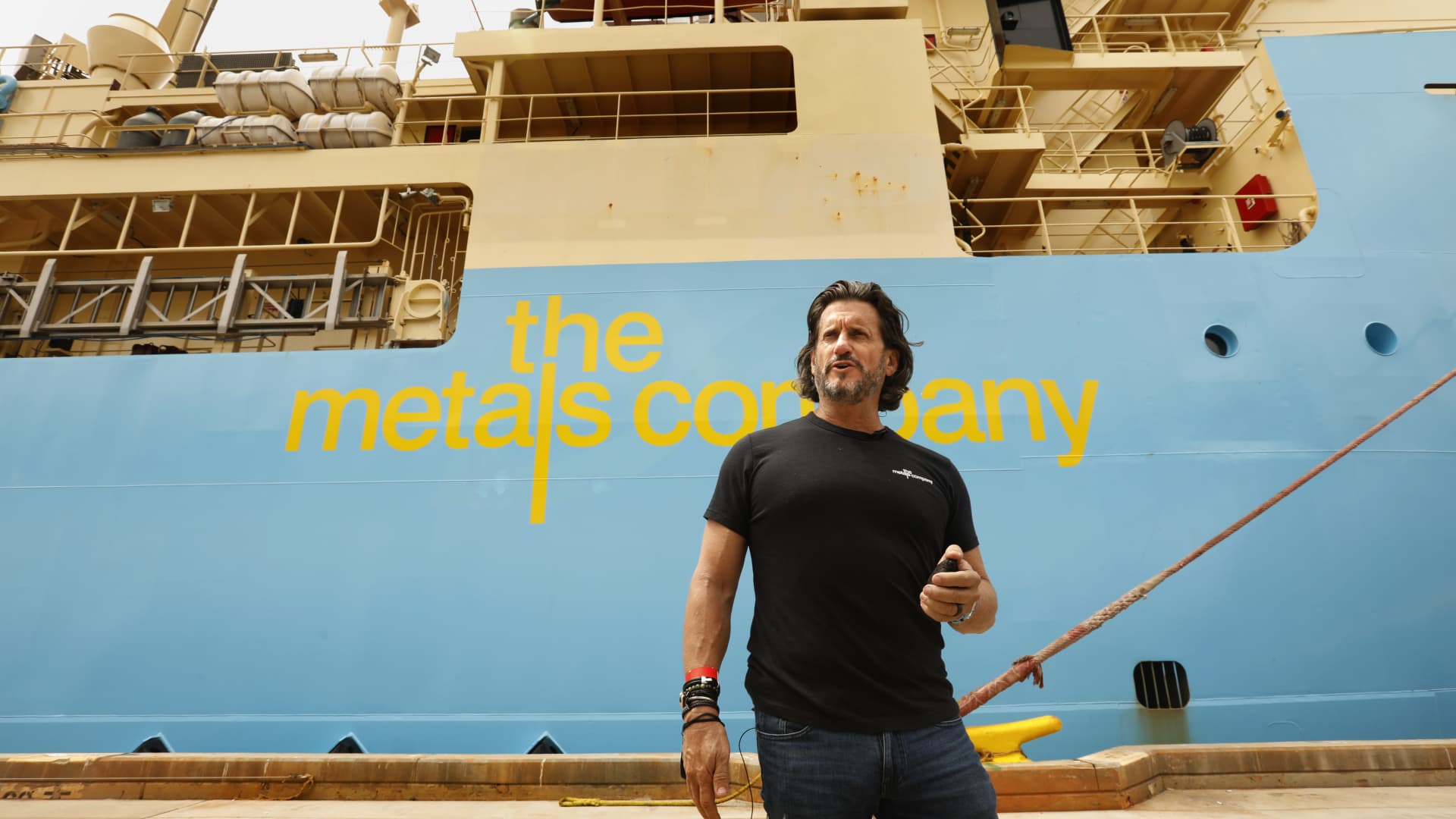The Metals Company puts out controversial timeline for deep sea mining

Gerard Barron, Chairman and CEO of The Metals Company, hopes that his company will be able to mine the seafloor for nickel, cobalt, manganese in the Pacific Ocean.
Carolyn Cole | Los Angeles Times | Getty Images
The debate over whether companies should be permitted to collect metal nodules off the floor of the deep sea has been grinding slowly for years, with both sides deeply entrenched in their positions.
The debate got more intense this week when The Metals Company, a company looking to mine those nodules, on Tuesday stated an aggressive timeline for moving forward. The Metals Company was founded in 2011 and raised $400 million from a combination of strategic partners such as Allseas and Glencore, financial institutions, venture funds, and family offices. It then went public in 2021 through a special purpose acquisition company, or SPAC and is looking to establish deep sea mining as a business.
Those who oppose deep sea mining say the ocean floor contains sea life that does not exist elsewhere and should not be disturbed. Those who support it say the metal nodules contain commodities that are needed for the clean energy transition, and collecting them off the ocean floor is better than mining them on land in biodiverse territory or with inhumane labor conditions.
On Tuesday, The Metals Company said it intends to submit an application to mine the deep sea floor after the July 2024 meeting of the International Seabed Authority, an intergovernmental organization that issues rules governing 54% of the world’s oceans.
The Metals Company went further to say that it expects a one-year review process, leading to production in the fourth quarter of 2025.
Right now, however, there are no established regulations or environmental standards in place. The Metals Company says it’s leaving ample time for those rules to be finalized, but opponents say the company is bolting out ahead of the collective efforts to come to a consensus about regulating the deep seas.
In one indication of the intensity of the debate, there were dueling interpretations of the relative progress made at the most recent ISA delegate meetings in July. The ISA press office sent out a statement saying it had made “significant” progress on mining regulations, and that they were expected to be completed at the Authority’s next sessions in 2024. Then it corrected the press statement to say 2025.
The Metals Company at the time said it “applauded” the ISA’s “consensus decision agreeing a roadmap towards adopting final rules, regulations, and procedures” to allow deep sea mining in international waters.
But Diva Amon, a deep-sea marine biologist opposed to mining, disputed these accounts.
Gerard Barron, Chairman and CEO of The Metals Company, holds a nodule brought up from the sea floor, which he plans for his company to mine the seafloor for these nodules in the Clarion Clipperton Zone of the Pacific Ocean. The Maersk Launcher research ship recently returned to San Diego after conducting core sample from deep in the ocean floor in the Clarion Clipperton Zone.
Carolyn Cole | Los Angeles Times | Getty Images
“While there was progress on the deep-sea mining code, I certainly wouldn’t say it was ‘significant’ as listed in the ISA’s press release,” Amon told CNBC. “I gather many States and Observers were quite angry at the inaccurate reporting” as reflected in the corrected press release.
Activists at Greenpeace were even harsher in their assessment.
“This week, the ISA has been dominated by discussions of how to start deep sea mining thanks to a handful of delegations — namely Norway, Mexico, the United Kingdom and the desperate efforts of The Metals Company. That’s totally the wrong focus in a climate and nature emergency,” Louisa Casson, the deep sea mining campaign lead at Greenpeace, said in a statement released on July 24.
“Voices against deep sea mining have never been so loud — from the fishing sector to financiers, indigenous peoples, scientists and big business.”
Why the debate is so deeply polarized
The polymetallic nodules The Metals Company wants to harvest include nickel, cobalt, copper and manganese.
“These minerals are in demand, along with other critical minerals, for the use in energy storage and electric vehicles, in the movement towards clean energy,” explained Charlotte Selvey Miller, the head of sustainability at Benchmark Mineral Intelligence, which specializes in tracking the metals used for the clean energy transition. The Metals Company commissioned Benchmark to model the environmental impacts of producing these metals from by collecting them from the deep sea floor and processing them in land-based facilities in Texas.
The minerals in the polymetallic nodules are also found on land, Miller said. Nickel is found Canada, Indonesia and Russia, and cobalt is mostly found in the Democratic Republic of the Congo, she told CNBC.
Dump trucks seen at the Nickel mine, operated by PT Vale Indonesia in Sorowako. U.S. Geological Survey Shows that Indonesian nickel reserves ranked first, reaching 21 million tons or equivalent to 22% global reserves.
Sopa Images | Lightrocket | Getty Images
“The demand for land- based minerals outweighs supply by far, and even considering recycling, we will be in a deficit in cobalt and nickel as early as 2026 for cobalt and 2027 for nickel according the Benchmark Minerals risk-weighted supply forecast,” Miller said.
Benchmark’s analysis found that the deep sea mining model “resulted in a better environmental performance than analyzed traditional land processing routes in the majority of the impact categories,” Miller told CNBC. For example, the global warming potential of The Metal Company’s route are generally 54 to 70 percent lower than conventional on land mining routes, Benchmark found.
But Miller also said the commissioned analysis by Benchmark does not analyze all environmental factors, such as biodiversity. In addition, the findings of the study do not mean that Benchmark is endorsing deep sea mining, Miller added.
Other environmental assessments call the value of the mining into question.
A report from the non-profit Planet Tracker published in June found the cost of restoring the floor of the deep sea would be between $5.3 to $5.7 million per square kilometer, which is about two times the cost of mining it, and more than the revenue that would be generated by selling the nodules, which Planet Tracker estimated to be $4.4 million per square kilometer.
Amon, the marine biologist, told CNBC previously that damage to the sea floor will be “irreversible” if mining does go forward. “This is a thriving ecosystem,” Amon told CNBC in March. “Sure, many of the animals are small in size, but that doesn’t make them any less important.”
But Barron, The Metals Company’s CEO, says the clock is ticking for climate action, and mining the deep sea floor is a less damaging alternative than either not getting access to the metals needed in the transition or continuing to extract them from land-based resources.
“We can’t be swayed by narrow views who just want to stop everything because that’s not going to lead us towards addressing global warming,” Barron told CNBC in a video conversation on Monday. Mining for metals in Indonesia causes deforestation and biodiversity loss and is displacing indigenous communities, Barron said. And mining for cobalt is infamously exploitative of child labor.
“That’s our reality. And we can change that,” Barron said. “Sometimes people say to me, ‘You’re not going to solve anything. You’re just adding another problem.’ But that’s not true. We can slow down the expansion of rainforests nickel.”
But this is unrealistic, Amon has previously told CNBC. Deep sea mining won’t replace land-based mining, but will simply add another source of minerals, she said in March.
A general view of artisanal miners working at the Shabara artisanal mine near Kolwezi on October 12, 2022. Some 20,000 people work at Shabara, in shifts of 5,000 at a time. Congo produced 72 percent of the worlds cobalt last year, according to Darton Commodities. And demand for the metal is exploding due to its use in the rechargeable batteries that power mobile phones and electric cars. But the countrys poorly regulated artisanal mines, which produce a small but not-negligeable percentage of its total output, have tarnished the image of Congolese cobalt.
Junior Kannah | Afp | Getty Images
What’s next?
The ISA has granted approvals for contractors to explore metals in the deep seabed, and some of these exploration applications are for polymetallic nodules in the Clarion Clipperton Zone, an area of particular focus in the central Pacific, about 1,000 miles from the west coast of Mexico. The Metals Company holds some of these licenses, which it was able to obtain through sponsorship from the tiny Pacific island nations of Nauru, Tonga and Kiribati.
But actually taking the metals from the seabed requires an exploitation license.
In the summer of 2021, the president of Nauru submitted a letter to the ISA requesting that the organization finalize rules so that this exploitation application could be approved to begin work in two years.
So The Metals Company says it is its legal right to submit an application for exploitation anytime after July 9, 2023.
But Pradeep Singh, an expert in ocean governance and a member of the International Union for Conservation of Nature delegation to the ISA, says The Metals Company is overly optimistic in its timeline and is underestimating the time it will take to get international governance rules for mining agreed upon.
“It’s definitely not the case that the Council is inviting applications; rather, I believe the message the Council, and many member states, is trying to send is one seeking to strongly dissuade any applications under the two-year rule,” Singh told CNBC.
The pilot nodule collector vehicle designed by Allseas for use by The Metals Company. Photo provided by The Metals Company.
Photo courtesy The Metals Company
“I would add that what the Council did explicitly decide — thrice now since March — is that commercial exploitation should not commence in the absence of regulations,” Singh told CNBC.
Regardless, Singh says, there is a lot of work yet to be done by members of the Council to establish regulations before any deep sea mining commences.
“The message I would give to current and prospective investors of any deep sea mining company is that it’s still a long and winding road ahead with many uncertainties,” Singh told CNBC.
“There is a very high chance of applications submitted before 2025 being rejected or being subject to extremely stringent and unfavorable conditions,” Singh said. “States were quite clear in that they are not prepared to be rushed or cornered into allowing deep sea mining to start anytime soon, especially where the risks far outweigh any potential benefits at this point in time. Current and prospective investors should bear that in mind.”




